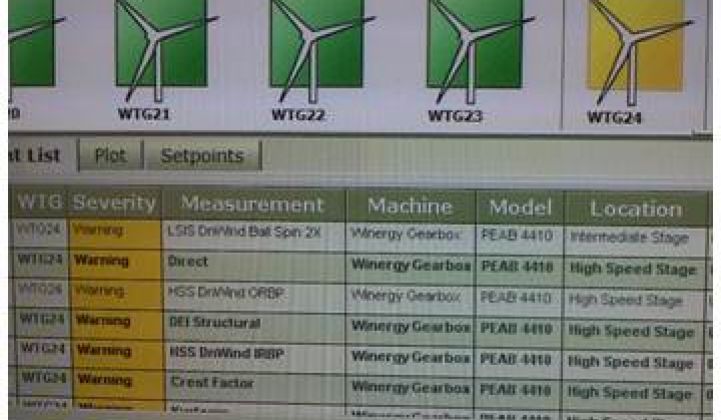GE Energy is U.S. wind’s heavy hitter. With its 1.5-megawatt machine, it has long been the second-biggest turbine maker in the world. But new turbines are getting bigger and better, the industry’s center of gravity is shifting to Asia, and Chinese manufacturers, backed by their cash-rich government, are driving competition. Consolidation rumors foretell the fall of giants. Still, announcements from GE’s wind group at Windpower 2011 suggest it may keep slugging.
The announcement that installation has begun on 338 GE 2.5-100 turbines at Caithness Energy’s 845-megawatt Shepherd’s Flat Project in Oregon, which, upon commissioning in 2012, will be the biggest onshore wind project in the world, seemed to solidify the bigger GE machine’s place as the new industry standard.
But another announcement -- that GE had locked in U.S. and Brazilian orders for 393 of its new 1.6-100 turbines -- suggests something different. The 1.6-100’s design, which includes the 2.5-100’s 100-meter-long blades, makes it possible to generate economic levels of electricity in low-wind settings and makes previously untenable projects bankable.
“Different parts of the country require different solutions,” explained Richard Reno, Wind Product General Manager in GE Energy’s Renewables Division. “For Caithness, to maximize the return for that situation, bigger machines are the answer. Where they have a different set of constraints, a turbine with a very high capacity factor, like our 1.6-100, provides the best returns.”
In short, a rapidly maturing industry exploring a greater variety of resources requires a variety of options. A single standard is as inapplicable as a standard car for all drivers. “It really comes down to what problems are you trying to solve and how do our products fit in?” Reno said.
Two other GE announcements highlighted the fact that wind economics are about more than just the right turbine.
The digital nervous system of a modern turbine is monitored by multiple computer systems. The information is carried by cable, adding extra work to project installation and maintenance. GE has deployed the first project-wide wireless network for 39 GE 1.5-megawatt turbines at First Wind’s Milford I wind farm in Utah. Using a Cisco networking infrastructure, it supports data sharing and video and voice conferencing wirelessly through Internet Protocol-based technology.
“The goal is to bring the tech and the turbine as close to the engineers in the office as possible,” Reno explained. “We can stream live video so if the guy at the turbine is trying to troubleshoot a problem, it’s like there’s another guy looking over his shoulder -- and maybe it's the guy who designed the thing.”
The “thing” most central to turbine operations is the gearbox-drivetrain system. At Windpower this year, GE announced an upgrade to ADAPT.wind, software designed to address gearbox-drivetrain failure, the single most costly and time-consuming turbine malfunction. ADAPT.wind’s multiple algorithms track 150 separate system performance readings.
Windfarm owner-operators simply record “what type of gearbox they have [and] what type of generator -- we’ve done all the homework and derived the kinematics,” said Adam Weiss, the ADAPT.wind product manager for GE Measurement and Control Solutions. “We can generate the 150 measurements based on that specific unit. Then, in real time, we monitor those 150 measurements and look for changes or anomalies.”
On ADAPT.wind’s control screen, each turbine is represented by an icon with a red, yellow or green dot. Yellow dots “mean there’s something occurring but we don’t recommend any action yet -- but we should watch it,” Weiss said. Red dots mean “There’s something wrong.”
Clicking on a turbine’s icon allows users to access every detail of its operational history. GE’s control center evaluates the significance of yellow dots and decides when to schedule maintenance.
“We can tell you specifically where a fault is,” Weiss said. “And you don’t have to wait for catastrophic damage either. You know ahead of time.” This makes it possible to “know what parts to order, what parts to send the guy up the tower with and [to determine] if he can fix it up-tower.” If the repair requires a crane, Weiss added, the advance notice makes it possible to “wait for three, four or five turbines to have the problem, schedule the crane, and take care of them all at once.”
Plans are under way to expand ADAPT.wind’s capabilities beyond the gearbox-drivetrain complex, but GE is not providing details yet.
With this detailed foreknowledge and servicing capability, GE has developed production-based availability (PBA) guarantees for the turbines it maintains, a move that was also announced at Windpower. The PBA offers wind farm owner-operators a new level of protection against wind’s variability.
“The most a turbine can run is 100 percent of the time,” Richard Reno explained. “A typical guarantee would be, ‘We guarantee production 97 percent of the time, and anything below that, we will pay a penalty.’” However, Reno noted that “What that doesn’t protect you against is [the possibility that] that three percent of the time was during your best wind.”
Being down during the best winds, even for just one percent of the time, significantly lowers an owner-operator’s productivity.
Using its O&M operations, wired and wireless monitoring, software like ADAPT.wind, and new forecasting capabilities, GE is so confident it can proactively maintain a wind farm and keep the turbines available when winds are best that it is willing to guarantee optimum performance and commit to reimbursing owner-operators for falling short.
The PBA, Reno said, “incentivizes us to operate the farm as if it were our own" -- which gives a wind farm’s owner-operator the chance to put a slugger in the lineup.



